Creation Of Man
Stages of the creation of Man - (A)
Stages of the creation of Man - (B)
The Embryonic Phases
Qur'aanic Description of the Internal &
External Appearance Of the Fetus
| Stages Of The
Creation Of Man (A)
Allah Almighty sent the Prophet
Muhammad peace be upon him, (sallAllahu alaihi wa sallam), as a Messenger to the whole
universe. Allah Almighty says in the Qur'aan:
We sent thee not, but as a mercy for all
creatures. (Qur'aan 21:107).
And so Prophet Muhammad (sallAllahu alaihi wa sallam) is the
Messenger of Allah to the bedouins in the desert just as he is the Messenger of Allah to
the present-day scientist in his modern laboratory. He is the Messenger of Allah to all
peoples of all times. Before Prophet Muhammad (sallAllahu alaihi wa sallam), each
Messenger was sent exclusively to his own people: to every people a guide has been sent.
(Qur'aan 13:7).
Prophet Muhammad peace be upon him's
(sallAllahu alaihi wa sallam) message, however, is to all of mankind, and it is for this
reason that Allah Almighty has given a supporting proof of the message of Prophet
Muhammad peace be upon him (sallAllahu alaihi wa sallam), a proof which is
different from the proofs given to the messengers before him. The proofs of the preceding
messengers were only seen by their contemporaries and possibly by some generations
immediately following them. Then Allah Almighty would send a new Messenger,
supported with a new miracle, in order to revive the faith of his people. But because Prophet
Muhammad peace be upon him (sallAllahu alaihi wa sallam) was destined to be last of
the Prophets until the Day of Resurrection, Allah Almighty has given him an
everlasting miracle as a supporting proof.
If we ask a Jew or Christian to show us the
miracles of Prophet Musa (Moses) or 'Eesa (Jesus), may the blessings and peace of Allah
Almighty be upon them, they both would submit that it is not within human power to
re-demonstrate any of those miracles now. Moses cane cannot be created nor can Prophet
Jesus be invoked to raise people from the dead. For us today, these miracles are
nothing more than historical reports. But if a Muslim is asked about the greatest miracle
of the Prophet Muhammad peace be upon him (sallAllahu alaihi wa sallam), he
can readily show his book, the Qur'aan. For the Qur'aan is a miracle that remains in our
hands. It is an open book for all people to examine its contents.
Allah Almighty said in the Qur'aan:
What
thing is most weighty in evidence? Say: Allah is witness between me and you; this Qur'aan
has been revealed to me by inspiration that I may warn you and all whom it reaches.
(Qur'aan 6:19).
The
miraculous nature of the Qur'aan lies in the knowledge which it contains. Allah, the
Exalted, said: But Allah bears witness to that which He has sent down (the Qur'aan) you (O
Muhammad); He has sent it down with His Knowledge (Qur'aan 4:166).
Hence, our contemporary scientists and
scholars, the professors in various universities who are leaders of human thought, have
the opportunity to examine the knowledge which is found in the book of Allah Almighty.
In this age, scientists have excelled in discovering the universe, though the
Qur'aan has already discussed the universe and human nature even long before. So,
what was the result?
We present Professor Emeritus Keith Moore,
one of the worlds prominent scientists of anatomy and embryology. We asked Professor Moore
to give us his scientific analysis of some specific Qur'aanic verses and prophetic
traditions [Ahadeeth] pertaining to his field of specialization.
Professor Moore is the author of the
book entitled The Developing Human. He is Professor Emeritus of Anatomy and Cell
Biology at the University of Toronto, Canada, where he was Associate Dean of Basic
Sciences at the Faculty of Medicine and for 8 years was the Chairman of the Department
of Anatomy. Dr. Moore had also previously served at the University of Winnipeg, Canada
for eleven years. He has headed many international associations of anatomists and the
Council of the Union of Biological Sciences. Professor Moore was also elected to the
membership of the Royal Medical Association of Canada, the International Academy of
Cytology, the Union of American Anatomists and the Union of North and South American
Anatomists. and in 1984 he received the most distinguished award presented in the field of
anatomy in Canada, the J.C.B. Grant Award from the Canadian Association of
Anatomists.
He has published many books on clinical
anatomy and embryology, eight of them are used as reference works in medical schools
and have been translated into six languages.
When we asked Professor Moore to give us his
analysis of the Qur'aanic verses and prophetic statements, he was amazed. He wondered how
the Prophet Muhammad peace be upon him (sallAllahu alaihi wa sallam), fourteen
centuries ago, could describe the embryo and its development phase in such detail and
accuracy, which scientists have come to know only in the last thirty years. Very quickly,
however, Professor Moores amazement grew into admiration for this revelation and guidance.
He introduced these views to intellectual and scientific circles. He even gave a lecture
on the compatibility of modern embryology with the Qur'aan and Sunnah where he
stated:
It has been a great pleasure for me to
help clarify statements in the Qur'aan about human development. It is clear to me that
these statements must have come to Muhammad peace be upon him from Allah, or God,
because almost all of this knowledge was not discovered until many centuries later. This
proves to me that Muhammad peace be upon him must have been a Messenger of Allah."
Consider what this well-known and respected
scientist of embryology declared upon studying the Qur'aanic verse related to his
discipline, and his conclusion that Muhammad peace be upon him (sallAllahu
alaihi wa sallam), must have been a Messenger from Allah Almighty.
Allah Almighty
says in the Qur'aan about the stages of the creation of man: Man
we did create from a quintessence (of clay); Then we placed as (a drop of) sperm (nutfah)
in a place firmly fixed; Then we made the sperm into a clot of congealed blood (alaqah);
Then of that clot we made a (fetus) lump (mudghah); then we made out of that lump bones
and clothed the bones with flesh; then we developed out of it another creature.
(Qur'aan 23:12-14).
The Arabic word alaqah has three
meanings. The first meaning is leech. The second is a suspended thing. The
third meaning is a blood clot.
In comparing the fresh-water leech to the
embryo at the alaqah stage, Professor Moore found a great similarity between the
two. He concluded that the embryo during the alaqah stage acquires an appearance
very similar to that of leech. Professor Moore placed a picture of the embryo side by side
with the picture of a leech (See Fig. 3.1). He presented these pictures to scientists at
several conferences.

Fig. 3.1
The second
meaning of the word alaqah is a suspended thing, and this is what we can see in the
attachment of the embryo during the alaqah stage to the uterus (womb) of the mother. The third meaning of the word alaqah is a blood clot. It is
significant to note, as Professor Moore stated, that the embryo during the alaqah stage
goes through well known internal events, such as the formation of blood in closed vessels,
until the metabolic cycle is completed through placenta. During the alaqah stage,
the blood is caught within closed vessels and that is why the embryo acquires the
appearance of a blood clot, in addition to the leech-like appearance. Both descriptions
are miraculously given by a single Qur'aanic word alaqah.
How could Muhammad peace be upon him (sallAllahu
alaihi wa sallam) have possibly known that by himself? Professor Moore also studied the
embryo at the mudghah (chewed-like substance) stage. He took a piece of raw clay
and chewed it in his mouth, then compared it with a picture of the embryo at the mudghah
stage. Professor Moore concluded that the embryo at the mudghah stage acquires the exact
appearance of a chewed-like substance (Fig. 3.2) . Several Canadian periodicals
published many of Professor Moores statements. In addition, he presented three television
programs in which he highlighted the compatibility of modern science with what has been
contained in the Qur'aan for one thousand and four hundred years. Consequently, Professor
Moore was asked the following question: Does this mean that you believe that the
Qur'aan is the Word of Allah Almighty? to which he replied: I find no
difficulty in accepting this. Professor Moore was also asked: How can you believe
in Muhammad peace be upon him while you believe in Jesus Christ? His reply was:
"I believe they both come from the same school."
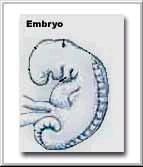 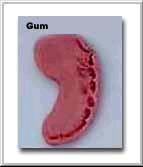
Fig. 3.2
Thus modern scientists all over the world
today can come to know that the Qur'aan has been revealed from Allah Almighty's
knowledge. As Allah the Almighty has told us: Allah bears witness that what
He has sent unto thee He has sent with His (own) knowledge. (Qur'aan 4:166).
It also follows that modern-day scientists
should have no difficulty in acknowledging that the Prophet Muhammad peace be upon him
(sallAllahu alaihi wa sallam), is a Messenger of Allah Almighty. |
Stages
Of Creation Of Man (B)
![[Embryo: (a) 5 to 6 Week (b) 7 Week (c) 7 Week]](CreationOfManB_00.jpg)
The book, The Developing Human written
by Professor Keith Moore has been translated into eight languages. This book is
considered a scientific reference work, and was chosen by a special committee in the
United States as the best book authored by one person. We met with the author of this book
and presented to him many Qur'aanic verses and Prophetic Ahadeeth which deal with
his specialization in embryology.
Professor Moore was convinced by our
evidence, so we asked him the following question: You mentioned in your book that in the Middle
ages there was no advancement in the science of embryology, and that only very
little was known at that time. At the same time the Qur'aan was being revealed to the Prophet
Muhammad peace be upon him (sallAllahu alaihi wa sallam), and he was guiding
people according to what Allah Almighty revealed to him. There is found in the
Qur'aan a very detailed description of the creation of man and of the different stages of
human development.
You are a world renowned scientist, so why do
you not uphold justice and mention these truths in your book? He replied: You have the
evidence and not I. So why do you not present it to us?
We provided him with the facts and Professor
Moore proved to be a great scholar. In the third edition of his book he did
make some additions. This book has been translated, as we mentioned previously, into eight
languages including Russian, Chinese, Japanese, German, Italian, Portuguese and
Yugoslavian. This book enjoys worldwide distribution and is read by many of the
worlds foremost scientists.
Professor Moore states in his book
about the Middle ages that: "Growth of science was slow during the medieval period,
and few high points of embryological investigation undertaken during this age are known to
us. It is cited in the Qur'aan, the Holy Book of the Muslims, that human beings are
produced from a mixture of secretions from the male and the female. Several references are
made to the creation of a human being from a sperm drop, and it is also suggested
that the resulting organism settles in the woman like a seed, six days after its beginning
(The human blastocyst begins to implant about six days after fertilization. See
Figure 4.1)."

Fig. 4.1
"The Qur'aan also states that the
sperm drop develops - into a clot of congealed blood. (An implanted blastocyst or
spontaneously aborted conceptus would resemble a blood clot.) Reference is
also made to the leech-like appearance of the embryo. The embryo is not unlike a leech, or
bloodsucker, in appearance. The embryo is also said to resemble a chewed piece of
substance - like gum or wood. (Somites somewhat resemble the teeth marks in a chewed
substance - see Fig. 4.2)."
Fig. 4.2
"The developing embryo was
considered to be human at 40 to 42 days and no longer resemble an animal embryo at this
stage. (See Fig. 4.3) (The human embryo begins to acquire human characteristics at
this stage). The Qur'aan also states that the embryo develops with - three veils of
darkness. This probably refers to (1) the maternal
anterior abdominal wall, (2) the uterine wall, and (3) the amniochorionic membrane. (see Fig. 4.4) Space does not
permit discussion of several other interesting references to human prenatal development
that appear in the Qur'aan."

Fig. 4.3
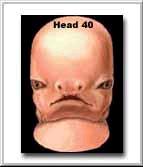 This is what Dr. Moore has written in his book,
praise be to Allah Almighty, and which is now being distributed throughout the
world. Scientific knowledge has made it incumbent upon Professor Moore to mention this in
his book. He has concluded that the modern classification of embryonic development stages,
which is adopted throughout the world, is not easy or comprehensive. It does not
contribute to the understanding of the embryonic stages of development because
those stages are on a numerical basis, that is, stage 1, stage 2, stage 3, etc. The
divisions that have been revealed in the Qur'aan do not depend on a numerical
system. Rather they are based on the distinct and easily identifiable forms or shapes
which the embryo passes through. This is what Dr. Moore has written in his book,
praise be to Allah Almighty, and which is now being distributed throughout the
world. Scientific knowledge has made it incumbent upon Professor Moore to mention this in
his book. He has concluded that the modern classification of embryonic development stages,
which is adopted throughout the world, is not easy or comprehensive. It does not
contribute to the understanding of the embryonic stages of development because
those stages are on a numerical basis, that is, stage 1, stage 2, stage 3, etc. The
divisions that have been revealed in the Qur'aan do not depend on a numerical
system. Rather they are based on the distinct and easily identifiable forms or shapes
which the embryo passes through.
The Qur'aan identifies the stages of pre-natal
development as follows:
- Nutfah, which means a drop or small amount of water;
- alaqah,which means a leech-like structure;
- mudghah, which means a chewed-like structure;
- idhaam, which means bones or skeleton;
- kisaa ul idham bil-laham, which means the clothing of bones with flesh or muscle,
- al-nash'a which means the formation of distinct fetus.
Professor Moore has recognized that these
Qur'aanic divisions are actually based on the different phases of pre-natal development.
He has noted that these divisions provide elegant scientific descriptions that are
comprehensible and practical.
In one of the conferences he attended,
Professor Moore stated the following: "The embryo develops in the mothers womb or
uterus protected by three veils, or layers, as shown in this next slide [exact slide not
shown - Ed.]. (A) represents the anterior abdominal
wall, (B) the uterine wall, and the (C) the amniochorionic membrane. (see Figure 4.5) Because the
staging of human embryo is complex, owing to the continuous process of change during
development, it is proposed that a new system of classification could be developed using
the terms mentioned in the Qur'aan and Sunnah. The proposed system is simple,
comprehensive, and conforms with present embryological knowledge."
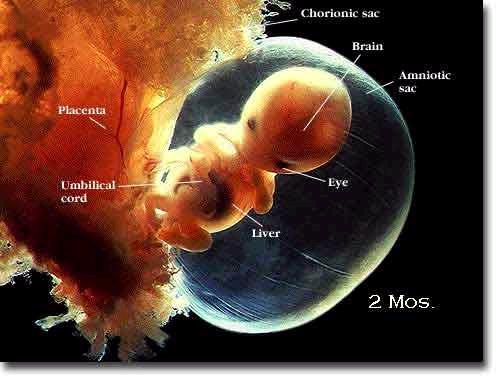
Fig. 4.4
"The intensive studies of the Qur'aan and Ahadeeth in the
last four years have revealed a system of classifying human embryos that is amazing
since it was recorded in the seventh century A.D. Although Aristotle, the
founder of the science of embryology, realized that chick embryos developed in stages from
his studies of hens eggs in the fourth century B.C., he did not give any details about
these stages. As far as it is known from the history of embryology, little was known
about staging and classification of human embryos until the twentieth century.
For this reason, the descriptions of the human embryo in the Qur'aan cannot be based on
scientific knowledge in the seventh century. The only reasonable conclusion is that these
descriptions were revealed to Muhammad peace be upon him (sallAllahu alaihi
wa sallam) from Allah Almighty. He could not have known such details because he was
an unlettered man with absolutely no scientific training."
We told Dr. Moore, What you have said is
true, but it is far less than the truth and evidence we have presented to you from the Qur'aan
and the Sunnah and which are related to the science of embryology. So why not do
justice and completely bring to light all the Qur'aanic verses and Ahadeeth which deal
with your field of specialization?.
Professor Moore said that he has
inserted the appropriate references at the appropriate places in a specialized scientific
book. However, he would invite us to make some Islamic additions, citing all the relevant Qur'aanic
verses and the prophetic Ahadeeth, and highlighting their various miraculous aspects,
to be incorporated at appropriate places in the book. This was done, and consequently,
Professor Moore wrote an introduction to these Islamic additions and the result was this
one which you see here before you. On each page that includes facts about the science of
embryology, we have cited the Qur'aanic verses and Prophetic Ahadeeth which prove the
inimitability of the Qur'aan and Sunnah. What we are witnessing today is Islam moving to
new grounds within fair and unbiased human minds.
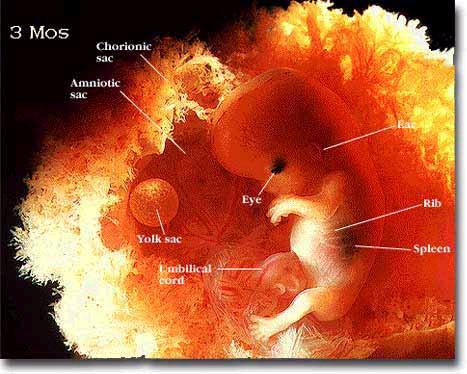
Fig. 4.5
The
Embryonic Phases
We present to you Dr. G.C. Goeringer,
Course Director and Associate Professor of Medical Embryology at the Department of Cell
Biology, School of Medicine, Georgetown University, Washington, D.C.. We met with him
and asked him whether in the history of embryology there was any mention of the different
stages of embryonic development and whether there were any books on embryology at the time
of the Prophet Muhammad peace be upon him (sallAllahu alaihi wa sallam) or
the centuries after him which mention these various stages, or whether the division into
these different stages only came to be known in the middle of the nineteenth century.
He said that the ancient Greeks were concerned with the study of embryology and many of
them attempted to describe what happens to the fetus and how it develops. We agreed with
him that Aristotle, among others, attempted to expound some theories on the
subject, but was there any mention made of these stages?
We know that these stages were not
known until the middle of the nineteenth century and were not proven until the beginning
of the twentieth century. After a long discussion, Professor Goeringer concurred
that there was no mention of these phases. Thus we asked him if there was any specific
terminology applied to these phases similar to that found in the Quraan. His reply
was negative. We asked him: What is your opinion on these terms which the Quraan
uses to describe the phases which the fetus goes through? After long discussions, he
presented a study at the 8th Saudi Medical Conference. He mentioned in the study
man's basic ignorance of these phases. He also discussed the comprehensiveness and
precision of these Quraanic terms in describing the development of the fetus by
means of concise and comprehensive terms which convey far reaching truth. Let us listen to
Professor Goeringer as he explains his opinion:
"In a relatively few aayahs
(Quraanic verses), is contained a rather comprehensive description of human development
from the time of the commingling of the gametes through organogenesis. No
such distinct and complete record of human development such as classification,
terminology, and description existed previously. In most, if not all, instances, this
description antedates by many centuries the recording of the various stages of human
embryonic and fetal development recorded in the traditional scientific literature."
The discussion with Professor Goeringer led
us to talk about a fact which was discovered recently and which would eliminate any
controversy. Although the virgin birth of Christ has been a Christian belief for
centuries, some among the Christians insist that Christ must have had a father, as a
virgin birth is scientifically impossible. They argue this, and perhaps they do not
know, that there could be a creation without a father. The Quraan replied to them
and has used as an example the creation of Adam. Allah Almighty said: The similitude of Jesus before Allah is as that of Adam; He created him
from dust, then said to him: Be: And he was. (Quraan 3:59).
There are three types of creation:
Adam, who was created without a mother or father
Eve, who was created without a mother
Jesus Christ, who was created without a father
Therefore, the One who was able to create Adam
without a father or a mother is also able to create Jesus from a mother and without
a father. In spite of this, the Christians still continue to argue even though Allah
Almighty has sent them evidence after evidence and proof after proof. Then when
they are asked why they persist in this controversy, they reply that they have never seen
or heard of anybody being created without a father and a mother. But modern science now
revealed that many animals and beings in this world are born and reproduced without fertilization
from the male of the species. For example, a male bee is no more than an egg which has not
been fertilized by the male, whereas the egg which has been fertilized by the male
functions as a female. Moreover, male bees are created from the eggs of the queen but
without fertilization by a male. There are many other examples such as this in the animal
world. Moreover, man today has the scientific means of stimulating the female's egg of
some organisms so that this egg develops without fertilization by a male.
Let us read the words of Professor Goeringer:
"In another type of approach, unfertilized eggs of many species of amphibians and
lower mammals can be activated by mechanical (such as pricking with a needle), physical
(such as thermal shock), or chemical means by any of a number of different chemical
substances, and continue to advance to stages of development. In some species, this type
of parthenogenetic development is natural."
Allah Almighty has given us the
definitive answer and he used Adam, whom they believe in, as an example of a human
being who has no father or mother. The Christians regard as deviance the fact that a human
being can be born without a father. Thus, Allah Almighty has shown them an analogy
of a human being who had no father and no mother, that is, Adam. The Quraan says: The similitude of Jesus before Allah is as that of Adam; He created him
from dust, then said to him: Be: and he was. (Quraan 3:59).
Allah Almighty has willed that there
be such scientific advancements and discoveries which provide proof after proof of the
truth which has been revealed in the Quraan. It is in this way that the verses of
this glorious book were revealed with the passage of time. The verses become known to the
foremost scholars and scientists of our religion and of generations to come. Science will
never deplete the wonders of the Quraan.
And
those to whom knowledge has come see that the (Revelation) sent down to you from your Lord
- that is the truth, and that it guides to the path of the Exalted (In Mighty), worthy of
all praise. (Quraan 34:6).
Allah Almighty, may He be Exalted and Glorified, said in the Quraan: And you shall
certainly know the truth of it (all) after a while. (Quraan, 38:88).
Allah Almighty
also said: For every prophecy is a limit of time, and soon shall
you know it. (Quraan 6:67).
And He said: Soon will we show them our signs in the (furthest) regions (of the earth),
and in their own souls, until it becomes manifest to them that this is the truth. Is it
not enough that your Lord does witness all things? (Quraan 41:53).
Qur'aanic
Description Of The Internal & External Appearance Of Fetus
 We present to you Dr. Marshall Johnson, Professor Emeritus of Anatomy
and Developmental Biology at Thomas Jefferson University Philadelphia, Pennsylvania,
U.S.A. There for 22 years he was Professor of Anatomy, the Chairman of the
Department of Anatomy, and the Director of the Daniel Baugh Institute. He was also the President
of the Teratology Society. He has authored more than 200 publications. We first met
with Professor Johnson at the 7th Saudi Medical Conference, where a special committee was
formed to investigate scientific signs in the Qur'aan and the Sunnah. We present to you Dr. Marshall Johnson, Professor Emeritus of Anatomy
and Developmental Biology at Thomas Jefferson University Philadelphia, Pennsylvania,
U.S.A. There for 22 years he was Professor of Anatomy, the Chairman of the
Department of Anatomy, and the Director of the Daniel Baugh Institute. He was also the President
of the Teratology Society. He has authored more than 200 publications. We first met
with Professor Johnson at the 7th Saudi Medical Conference, where a special committee was
formed to investigate scientific signs in the Qur'aan and the Sunnah.
When we met together with the committee, Professor
Johnson asked us what our committee was doing. We told him that the subject of our
study was the relationship between what the Qur'aan and Sunnah contained 1400 years ago
and what modern scientists tell us. He asked: "Like what?" We said: For
example, modern science tells us that the human prenatal development goes through
several stages whereas the Qur'aan mentioned these stages to us 1400 years ago.
Professor Johnson was appalled when he
heard this. He expressed his feeling by simply saying: No no, no! What kind of talk is
that?
We understood the effect of such statements
upon him. We knew he was one of the foremost scientists in the United States. He
knew, of course, that after the discovery of the microscope in the 16th century,
physicians throughout the 17th century believed that a human beings origin began
entirely in the males semen, specifically in the males sperm. This picture (not shown) was
the evidence used by scientists in the 17th century, and partly in the 18th
century, to support their belief that the human being was created wholly from the male
sperm, but after the discovery of the ovum was larger than the sperm of the male.
In this way they ignored the role of the man in the 18th century, just as they had ignored
that of the woman in the 17th century.
It was not until the middle of the 19th
century when the scientists began to discover that the human embryonic development
took place in several successive stages. It was for this reason when Professor Johnson was
told that this information has been in the Qur'aan for 1400 years that he stood up
and shouted: No, No! So we in turn handed him a copy of the Qur'aan and showed him the
following verse which he read in the English translation:
What
is the matter with you, that you are not conscious of Allahs Majesty. Seeing that it is He
who has created you in diverse stages? (Qur'aan 71:13-14).
Then
we showed him this verse: He creates you in the wombs of your mother, in stages, one after
another, in three veils of darkness. (Qur'aan 39:6).
At this, Professor Johnson sat down
and said: "But this could be explained in three possibilities. The first is that it
can be mere coincidence."
So we collected more than 25 texts and
presented them to him. Then we asked him: Is it possible that these texts are coincidence?
Moreover, the Glorious Qur'aan has given each of these stages a name: the first
being the nutfah, or the drop of water, the second being the alaqah, a leech-like
substance, the third being the mudghah, or a chewed-like lump, the fourth
being bones, and then the clothing of the bones with flesh. Can all this be a coincidence?
He flatly said: "No."
Then we asked him: Then what remains? He
said: "The other possibility is that Muhammad peace be upon him had hold [of
a] powerful microscope."
We said: "You know that this sort of
minute and specialized knowledge, which has been contained in the Qur'aan, can only
be obtained by very powerful microscopes. And anyone possessing such powerful
microscopes must also possess very high technology, which must be reflected in his daily
living, his house, his food, his control and management of war and quest for peaceetc. And
you know that technological advancement is a process of cumulative inheritance,
passed in and proved upon from one generation to the other."

Fig. 6.1
Professor Johnson laughed and said:
"In fact I saw the first microscope invented in the world. It does not magnify
more than 10 times and does not even show a clear picture."
The Prophet Muhammad peace be upon him
(sallAllahu alaihi wa sallam), never had possession of scientific equipment or
microscopes. The only thing that remains for us to say that he was a Messenger from Allah
Almighty. After this, Professor Johnson began to take interest in the study of
scientific signs in the Qur'aan, concentrating in some of his research on the stages of
embryonic development. While Dr. Moore and others discussed the external fetal
appearance, Professor Johnson concentrated his presentation on the Qur'aans
detailed descriptions of the internal as well as external of the fetus.
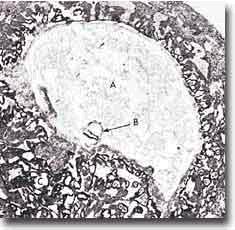
Fig. 6.2
Professor Johnson: In summary, the
Qur'aan describes not only the development of external form, but emphasizes also the
internal stages, the stages inside the embryo, of its creation and development,
emphasizing major events recognized by contemporary sciences.
For example, this drawing of the mudghah
[Fig. 6.3], or the chewed-like structure, is one of the things that Professor Johnson
used as evidence.

Fig. 6.3
This picture of the mudghah shows the
external appearance of the embryo with its curved structure, and with visible
protuberances and grooves resembling teeth-marks, we notice the swallows and the
grooves, we also notice the curved surface, all which give the embryo its distinctive
features while the embryo at this stage is only one centimeter in length.
If we were to make an incision in the
embryo and dissect the internal organs, we would find that most of them are already
formed, as it is apparent here. You can also see from this picture that some of the cells
have already formed, while others are not yet completely formed.
How then would we describe this embryo?
What do we say? Could we say it is the complete creation? Then we are describing the part
which is already created, and if we say it is an incomplete creation, then we are
describing the part which is not yet created, the question would be: Is it a complete
creation or is it an incomplete creation? There is no better description of that stage of
embryologenesis than the Qur'aanic description which says: mudghah
(chewed-like structure) partly formed and partly unformed (Qur'aan 22:5).

Fig. 6.4
Here is Professor Marshall Johnson
giving the conclusion of his research: "As a scientist, I can only deal with things
which I can specifically see. I can understand the words that are translated to me from
the Qur'aan. As I gave the example before, if I were to transpose myself into that
era, knowing what I knew today in describing things, I could not describe the things which
were described. I see no evidence for the refutation of the concept that this individual, Muhammad
peace be upon him , had to be developing this information from some place. So I see
nothing here in conflict with the concept that Divine Intervention was involved in
what he was able to write. 3
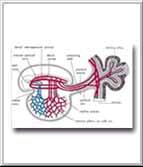
Fig. 6.5
Yes, it is the Revelation. The only way left
to mankind is to follow the example of those great scientists, acknowledging that Allah
Almighty has revealed to Muhammad peace be upon him (sallAllahu alaihi wa
sallam), a Book from Allah Almighty's knowledge. Allah has further promised
that mankind will, over time, come to discover the signs which prove that the Qur'aan
is truly a Book revealed by Allah Almighty.
Allah Almighty, may He be Exalted and
Glorified, said in the Quraan:
And
you shall certainly know the truth of it (all) after a while. (Quraan,
38:88)
Allah Almighty also said:
For
every prophecy is a limit of time, and soon shall you know it. (Quraan
6:67)
And said:
Soon
will we show them our signs in the (furthest) regions (of the earth), and in their own
selves, until it becomes manifest to them that this is the truth. Is it not enough that
your Lord does witness all things. (Quraan 41:53)
|


![]()